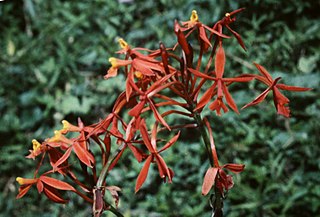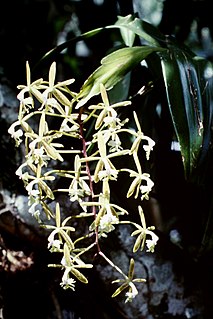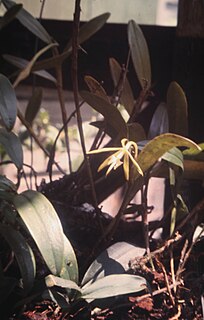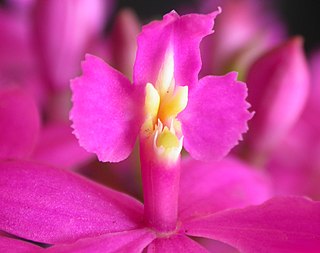
Epidendrum, abbreviated Epi in the horticultural trade, is a large neotropical genus of the orchid family. With more than 1,500 species, some authors describe it as a mega-genus. The genus name refers to its epiphytic growth habit.
Within the Orchidaceae, Hormidium was originally a subgenus of the genus Epidendrum, but was later raised to a full genus. It is now considered not to be distinct from the genus Prosthechea, of which it is a synonym. Most of the species of Hormidium have been transferred to Prosthechea, although others are now classified in Encyclia, Epidendrum, Homalopetalum, and Lepanthes.

Epidendrum flexuosum, a reed-stemmed Epidendrum common at mid-altitudes in Central America, is a species of orchid commonly called Epidendrum imatophyllum. It grows exposed to intense sunlight in the forest canopy, particularly on Guava species. E. flexuosum bears non-resupinate lavender flowers on a congested raceme at the end of a long peduncle.

Epidendrum compressum is a species of orchid in the genus Epidendrum from wet montane forests of Trinidad, Venezuela, Colombia, Ecuador, Peru and Bolivia.

Epidendrum macrocarpum, widely known as Epidendrum schomburgkii, is a species of orchid in the genus Epidendrum, and the largest-flowering crucifix orchid species. Reichenbach thought that E. fulgens and E. schomburgkii var. confluens were both synonyms for this species.

Epidendrum ibaguense is a species of epiphytic orchid of the genus Epidendrum which occurs in Trinidad, French Guyana, Venezuela, Colombia and Northern Brazil.

Epidendrum rigidum is an epiphytic reed-stemmed Epidendrum orchid common throughout the Neotroical lowlands, below 600 m.

John Lindley published Epidendrum subg. Spathium of the Orchidaceae. According to Lindley's diagnosis, the E. subg. Spathium is recognizable by is sympodial habit with individual stems being slender and covered by the bases of the distichous leaves, by the lip of the flower being adnate to the column to its apex, and by the inflorescence emerging from at least one spathe, similar to nearly all members of the genus Cattleya as understood in the year 2000. Reichenbach recognized 52 species in this subgenus, of which Kew accepts 48 :
The subgenus Pleuranthium of the genus Epidendrum of the Orchidaceae is distinguished from the other subgenera by having lateral inflorescences on the reed-like stems of the sympodial plant. With the exception of subgenus PsilanthemumKlotzsch, all of the remaining subgenera produce terminal inflorescences.

Epidendrum subsect. UmbellataRchb.f. (1861) is a subsection of section E. sect. PlanifoliaRchb.f. (1861) of subgenus E. subg. EpidendrumLindl. (1841) of the genus Epidendrum of the Orchidaceae. Plants of E. subsect. Umbellata differ from the other subsections of E. sect. Planifolia by producing inflorescences which are umbel-like. In 1861, Reichenbach recognized ten species in this subsection. Of these, nine are recognized with the same names by Kew :
Epidendrum subsect. Racemosa is a subsection of section E. sect. Planifolia of subgenus E. subg. Epidendrum of the genus Epidendrum of the Orchidaceae. Plants of Racemosa differ from the other subsections of E. sect. Planifolia by producing inflorescences which are racemes. In 1861, Reichenbach recognized 26 species in this subsection. These names correspond to 25 species currently recognized in the World Checklist of Selected Plant Families :
Epidendrum subsect. PaniculataRchb.f. 1861 is a subsection of section E. sect. Planifolia of subgenus E. subgen. Epidendrum of the genus Epidendrum of the Orchidaceae. Plants of E. subsect. Paniculata differ from the other subsections of E. sect. Planifolia by producing paniculate inflorescences. In 1861, Reichenbach recognized eighteen species in this subsection. From this group, Kew recognizes seventeen species :

Epidendrum subsect. CarinataRchb.f. (1861) is a subsection of the section E. sect. SchistochilaRchb.f. (1861) of the subgenus E. subg. AmphiglottiumLindl. (1841) of the genus Epidendrum of the Orchidaceae. This subsection differs from the subsection E. subsect. Integra in that the margins of the trilobate lip are dentate or lacerate. This subsection differes from the subsection E. subsect. Tuberculata by possessing a keel or carina on the midlobe of the lip. In 1861, Reichenbach listed nine species in this subsection.

Epidendrum sect. SchistochilaRchb.f. (1861) is a section of the subgenus E. subg. AmphiglottiumLindl. (1841) of the Genus Epidendrum of the Orchidaceae. E. sect. Schistochila differs from the section E. sect. Holochila in that the species in E. sect. Holochila have undivided lips; the species in E. sect. Schistochila have lobate lips. The species in both E. sect. Schistochila and E. sect. Holochila have racemose inflorescences, unlike those in E. sect. Polycladia, which have truly paniculate inflorescences. Like the other sections of E. subg. Amphiglottium, the members of E. sect. Schistochila are sympodial orchids bearing thin stems with alternate leaves, a long peduncle covered with thin, imbricating sheathes, and a lip adnate to the very end of the column.

Epidendrum sect. PolycladiaRchb.f. 1861 is a section of the Subgenus E. subg. AmphiglottiumLindl. of the Genus Epidendrum of the Orchidaceae. This plants in this section differ from the plants in the other sections of E. subg. Amphiglottium by having truly paniculate inflorescences: the section E. sect. Holochila is characterized by racemose inflorescences and an undivided lip, and the section E. sect. Schistochila is characterized by racemose inflorescences and a lobed lip.
Epidendrum hemiscleria is a sympodial epiphytic orchid native to the tropical cloud forest of Ecuador and Peru, at altitudes near 3.3 km.
The section Epidendrum sect. EquitantiaRchb.f. 1861 of the subgenus E. subg. EpidendrumLindl. 1841 of the genus Epidendrum of the Orchidaceae was published in 1861 by Reichenbach with the notation
Epidendrum parviflorum is a small-flowered reed-stemmed Epidendrum orchid found in the montane tropical wet forests of Bolivia, Ecuador, and Amazonas, Peru.

Epidendrum calanthum is a terrestrial reed-stemmed Epidendrum orchid from the montane Tropical rainforest of Bolivia, Colombia, Ecuador, Peru, Venezuela, and the West Indies.











